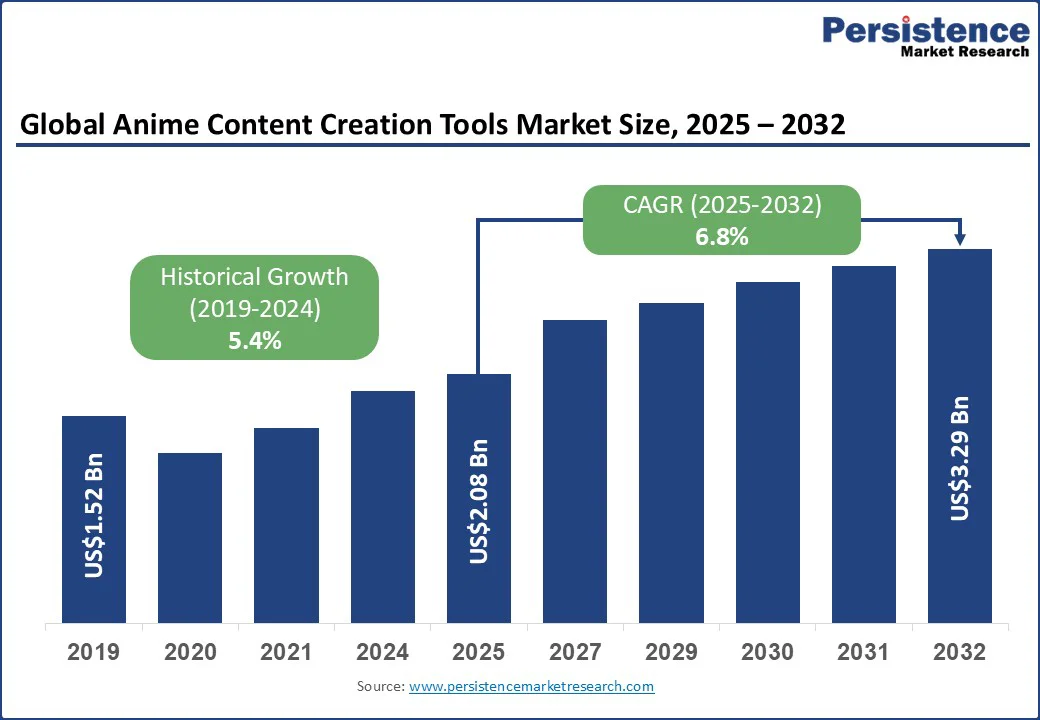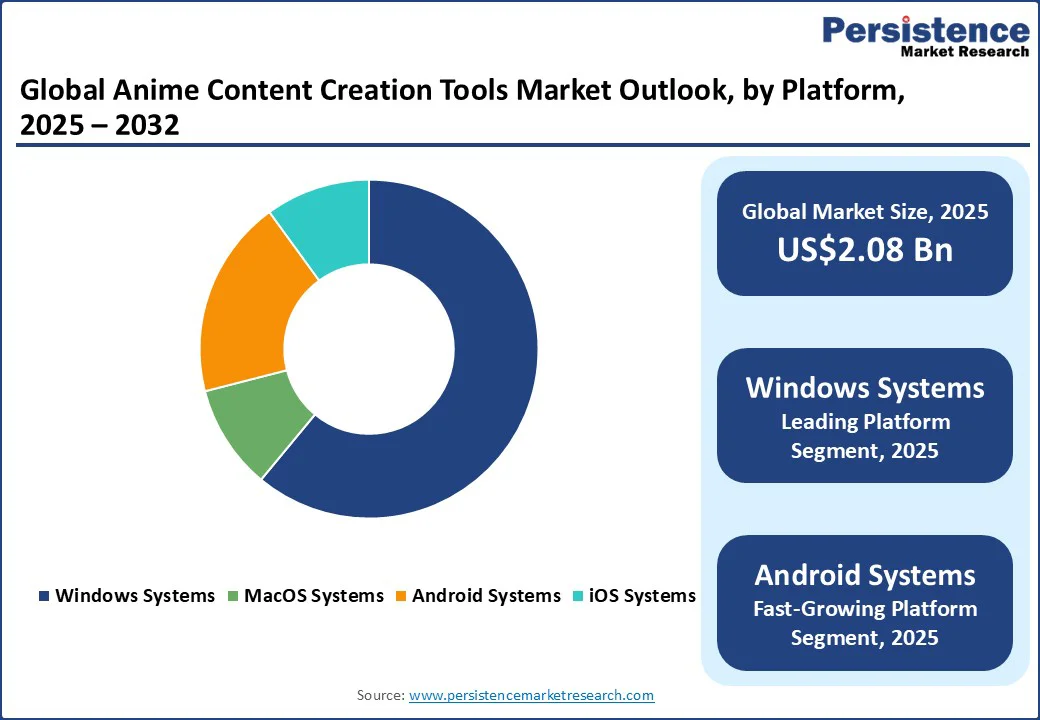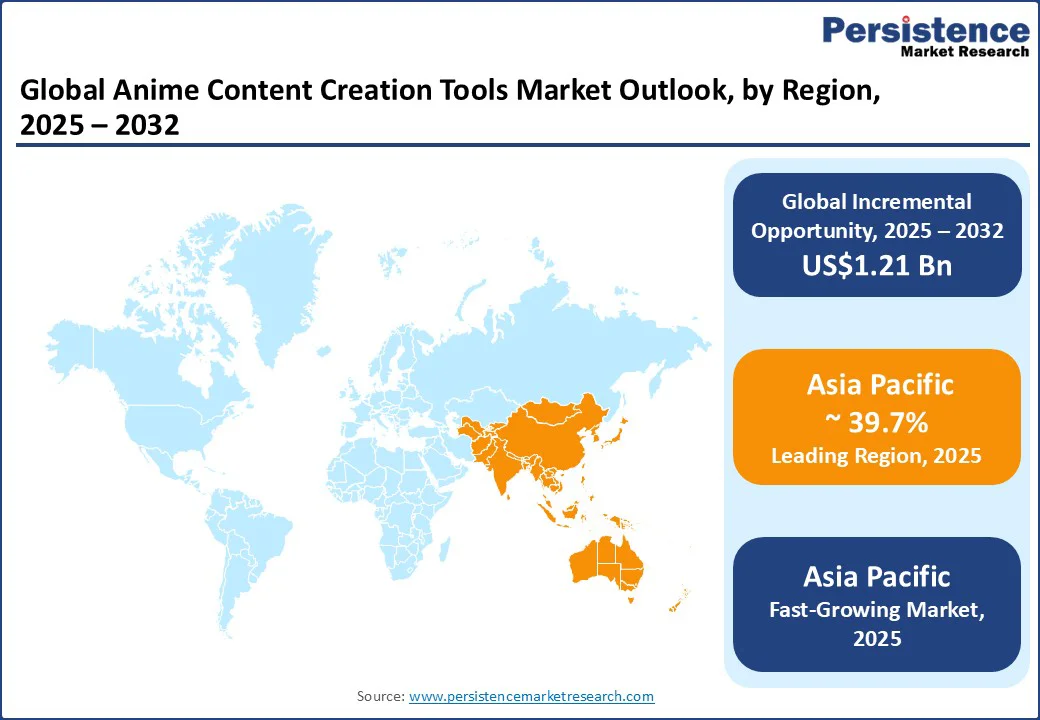ID: PMRREP35656| 195 Pages | 24 Sep 2025 | Format: PDF, Excel, PPT* | IT and Telecommunication

The global anime content creation tools market size is likely to be valued at US$2.08 Bn in 2025 and is expected to reach US$3.29 Bn by 2032, growing at a CAGR of 6.8% during the forecast period from 2025 to 2032, driven by the increasing demand for high-quality, visually engaging anime content across digital platforms and streaming services. Advancements in AI-assisted animation, virtual cameras, and real-time rendering engines have enhanced creative control and efficiency in episodic content development.
Key Industry Highlights

| Key Insights | Details |
|---|---|
|
Anime Content Creation Tools Market Size (2025E) |
US$2.08 Bn |
|
Market Value Forecast (2032F) |
US$3.29 Bn |
|
Projected Growth (CAGR 2025 to 2032) |
6.8% |
|
Historical Market Growth (CAGR 2019 to 2024) |
5.4% |
The integration of AI-assisted animation tools, including automated storyboarding, real-time frame generation, and voice synthesis, is transforming the anime production process. These technologies allow creators to automate repetitive tasks, freeing up time for more creative work and enhancing overall workflow efficiency.
AI-driven platforms can rapidly generate high-quality frames and suggest animation cues, significantly reducing production time and costs, proving valuable for independent studios and solo creators. For example, certain AI-powered software now enables real-time scene rendering and automatic lip-syncing, thereby accelerating the production of episodic anime content.
Cloud-based collaboration platforms are also reshaping the anime content creation landscape. By enabling real-time collaboration, seamless asset sharing, and efficient project management, these tools allow global teams to work together without friction. Studios engaged in co-productions or operating distributed teams can leverage these platforms to scale production and maintain consistent quality across projects. The flexibility offered by cloud-based tools supports faster iteration cycles and enhances the ability to meet tight deadlines, driving widespread adoption among both commercial studios and independent creators.
A notable challenge in the anime content creation tools market is the accessibility gap between professional-grade software and the tools available to emerging creators. Advanced animation platforms often require specialized technical skills and high-performance hardware, making it difficult for independent artists and smaller studios to adopt them effectively. This limitation restricts the democratization of anime production, concentrating high-quality content among established players while constraining new talent from bringing diverse stories to the market.
Fragmented workflows and limited interoperability among different content creation tools also pose significant obstacles. Creators frequently rely on multiple specialized platforms for tasks such as storyboarding, animation, and voice synthesis, which may not integrate seamlessly with one another. This disjointed approach can lead to inefficiencies, higher error rates, and longer learning curves for teams, particularly in cross-border collaborations.
The growing use of AI-driven animation software is opening up new possibilities for efficiency and creativity in the anime content creation tools market. Features such as automated character modeling, real-time frame rendering, and AI-assisted voice synchronization are reducing manual workload and accelerating production cycles. These capabilities allow studios to deliver more episodes within shorter timelines while enabling smaller creators to produce content at professional standards.
A practical example is the use of AI platforms that can generate detailed background environments from text prompts, which cuts down hours of manual design work and expands creative flexibility.
The increasing adoption of cloud-based collaboration platforms is creating strong opportunities for globally distributed anime production teams. These tools support real-time project management, asset sharing, and simultaneous editing across multiple locations, which is particularly valuable for cross-border co-productions.
By streamlining communication and reducing delays between different stages of production, cloud-driven workflows enhance scalability and improve delivery schedules. As demand for collaborative and multi-regional projects continues to rise, cloud-integrated anime creation platforms are expected to gain traction as a preferred solution in the industry.
Windows systems are anticipated to lead, accounting for nearly 61.4% of the market share in 2025. Their dominance is rooted in their compatibility with advanced animation suites, GPU acceleration, and extensive third-party plug-in ecosystems that professional studios and independent creators rely on. Large animation houses prefer Windows platforms due to their scalability and ability to handle intensive rendering tasks without workflow disruptions, making them the backbone of professional anime production.
In contrast, Android systems are the fastest-growing. The accessibility of Android devices, combined with stylus-enabled tablets and lightweight mobile applications, is lowering barriers for indie creators and hobbyists, particularly in emerging markets. This democratization of content creation is reshaping how entry-level creators contribute to the anime ecosystem. For example, in Southeast Asia, many small studios and freelancers use Android tablets to produce character sketches and short animations, later integrating them into larger production pipelines.
Anime series production is projected to dominate, accounting for approximately 43% of total market revenue in 2025. This segment benefits from the global surge in demand for serialized content, particularly from streaming platforms such as Netflix, Crunchyroll, and Amazon Prime, which are investing heavily in original anime series. Long-form storytelling and high production values make anime series a natural fit for professional-grade tools. Studios rely on AI-assisted animation, automated in-betweening, and cloud-based workflows to handle complex tasks such as character rigging, background detailing, and real-time rendering.
These tools help maintain consistency across multi-episode productions while reducing costs and turnaround times. Series production also supports broader monetization through merchandise, games, and spin-offs, justifying higher investment in quality and technology. Many series are developed through international co-productions, increasing the need for collaborative, multilingual, and cloud-native toolsets.
Webtoons and web animations are projected to grow at the fastest pace through 2032. This segment’s momentum is tied to the rising popularity of short-form, mobile-first content consumed on platforms such as LINE Webtoon and Tapas. The use of AI-assisted workflows, rapid asset reuse, and cost-efficient production models allows creators to deliver high volumes of content quickly.
A compelling example is Kakao Entertainment’s push to adapt popular Korean webtoons into animated series, highlighting how webtoon-focused tools are bridging the gap between short-form digital comics and mainstream anime productions.

Asia Pacific stands out as the dominant and fastest-growing region, with a market share of 39.7%, driven by its cultural connection to anime and the rapid expansion of digital content consumption. Japan continues to serve as the epicenter of anime production, yet the region is experiencing diversification with South Korea, China, India, and Southeast Asia taking on more active roles.
Mobile-first workflows are a defining trend here, with many independent creators and small studios using Android or iOS applications to sketch, storyboard, or produce short animations. This mobile adoption is pushing tool developers to design platforms that cater to both professional studios and entry-level creators.
Japan’s anime industry is deeply rooted in hand-drawn artistry, and production houses are increasingly investing in generative AI to accelerate secondary tasks such as background art, crowd scenes, and lip-syncing. The Japanese generative AI in the animation market was valued at approximately US$67 Mn in 2023 and is projected to grow almost tenfold by 2032, reflecting the industry’s openness to new technologies when applied carefully.
Studios are also adopting real-time rendering to reduce turnaround times without sacrificing stylistic authenticity, creating demand for tools that can bridge digital efficiency with the classic anime aesthetic. South Korea is shaping the future of webtoons and their adaptation into full-length anime. Platforms such as Kakao and Naver have cultivated massive digital comic ecosystems, and their growing investments in turning these properties into animated series are reshaping the tools landscape.. The increasing global popularity of Korean webtoons reinforces the importance of this segment, making South Korea a hotbed for tool innovation that supports scalable, mobile-first workflows.
North America holds a prominent position in the anime content creation, supported by strong demand from streaming platforms and a well-established base of production studios. The region has become a testing ground for advanced tools such as AI-powered lip-synchronization, automated character rigging, and real-time rendering engines. These technologies are enabling faster delivery of high-quality productions while keeping costs under control.
In the U.S., the market benefits from heavy investment in original anime productions by global streaming platforms such as Netflix, Amazon Prime, and Crunchyroll. Studios are increasingly adopting generative AI to automate complex tasks, though they are also mindful of balancing automation with creative integrity.
A recent consumer survey revealed that around 30 percent of viewers express discomfort with AI-generated animation, pushing U.S. studios to refine their approach by using AI selectively for efficiency while preserving the human touch in storytelling. The delay of high-profile titles like Witch Hat Atelier further highlights the industry’s emphasis on delivering uncompromised quality, underscoring the need for advanced but artist-friendly tools.
Canada is also emerging as an important contributor within North America. Cities such as Vancouver and Montreal are expanding their role as creative hubs, backed by favorable tax incentives and a growing pool of skilled animators. The combination of government support, a collaborative ecosystem, and demand for cutting-edge solutions positions Canada as an increasingly important growth market.
Europe is steadily strengthening its position in the anime content creation tools market, supported by rising consumer appetite for anime and anime-inspired productions. The region benefits from cultural funding and EU-level grants that encourage creative projects, including tool development for animation. European studios are particularly interested in solutions that facilitate cross-border co-production, multilingual localization, and compliance with content standards.
U.K. has become a focal point for anime-inspired production, with studios increasingly leveraging real-time rendering engines to accelerate episodic content creation for streaming platforms. Government tax credits for animation have created an attractive environment for investment, while indie creators are adopting mobile and tablet-based tools for pre-production work, such as storyboarding and character design.
France has also emerged as a significant market. French studios are adopting AI-driven tools to automate background art, apply stylization filters, and manage multilingual dubbing. The country is also seeing increased uptake of subscription-based animation software, which makes professional tools more accessible to small teams and freelancers. France’s position as a hub for international festivals and cultural exchanges further strengthens demand for high-quality anime production tools, encouraging innovation in both traditional studios and independent circles.

The global anime content creation tools market is highly competitive, shaped by a mix of established software providers, emerging AI-driven platforms, and regional innovators catering to niche demands. Leading companies such as Adobe, Autodesk, and Toon Boom dominate with comprehensive professional-grade suites widely adopted by studios, while specialized players such as Clip Studio Paint, TVPaint, and RETAS Studio hold strong positions in manga and anime-focused workflows.
At the same time, mobile-first platforms and AI-powered tools are rapidly gaining ground, particularly in Asia Pacific, where independent creators and webtoon producers require cost-efficient and scalable solutions. Strategic partnerships between software developers and streaming platforms are also intensifying competition, as vendors look to embed their tools within production pipelines for original anime series. This combination of global incumbents, agile regional challengers, and new AI entrants is fostering a dynamic market environment where innovation speed and adaptability are critical for maintaining leadership.
The anime content creation tools market size is estimated at US$2.08 Bn in 2025.
The market is expected to reach US$3.29 Bn by 2032.
Key trends include the adoption of AI-powered animation tools, cloud-based collaboration platforms, mobile-first workflows for webtoons, and the expansion of streaming platform-driven content production.
By platform, Windows systems are anticipated to hold the largest share of 61.4% in 2025.
The anime content creation tools market is projected to grow at a CAGR of 6.8% from 2025 to 2032.
Leading companies include Adobe Inc., Autodesk Inc., Toon Boom Animation Inc., Clip Studio Paint (CELSYS, Japan), and Reallusion Inc.
| Report Attribute | Details |
|---|---|
|
Historical Data/Actuals |
2019 - 2024 |
|
Forecast Period |
2025 - 2032 |
|
Market Analysis |
Value: US$ Bn |
|
Geographical Coverage |
|
|
Segmental Coverage |
|
|
Competitive Analysis |
|
|
Report Highlights |
|
By Platform
By Application
By Deployment
By End-user
By Region
Delivery Timelines
For more information on this report and its delivery timelines please get in touch with our sales team.
About Author